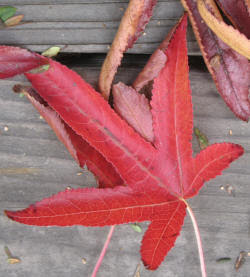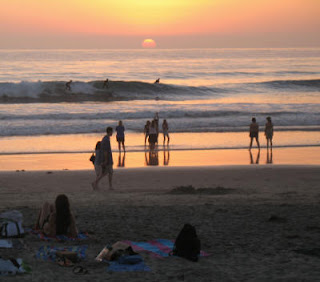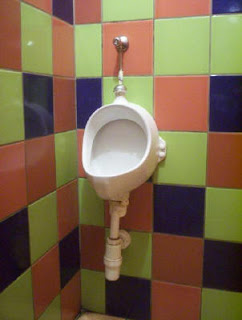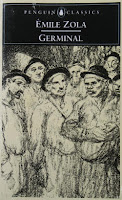 Every year my Christmas Cactus blooms in time for the holidays and every year I marvel at its timeliness.
Every year my Christmas Cactus blooms in time for the holidays and every year I marvel at its timeliness.
Merry Christmas, Everyone.
 Every year my Christmas Cactus blooms in time for the holidays and every year I marvel at its timeliness.
Every year my Christmas Cactus blooms in time for the holidays and every year I marvel at its timeliness.
 On the occasion of the One Hundredth Post
On the occasion of the One Hundredth Post It’s December—normally our trees are bare.
It’s December—normally our trees are bare. They wait for the cold to float them down.
They wait for the cold to float them down. Screaming color, they mark the season
Screaming color, they mark the seasonI wouldn’t call myself a sports fanatic, but the enthusiasm my husband holds for football and baseball leaks out and infects me. So I pay more attention to the NFL than I might otherwise.
Paul: “Hey, will you be showing the Packers/Cowboy game tomorrow night?”
Sports Bar #1 Greeter: “Sure, look at all our TVs.” (Waves hands around.) “Of course.”
Paul: “So you guys get the NFL network?”
Sports Bar #1 Greeter: “The NFL what? What’s that?”
Paul: “Can I talk to the manager?”
Sports Bar #1 Manager: “The NFL what? What’s that?”
Paul: “Hey, will you be showing the Packers/Cowboy game tomorrow night?”
Sports Bar #2 Manager (by-passing the Greeter): “Absolutely. I’m a Cowboy fan. I’m going to be watching it myself.” (Proudly.)
Paul: “Great, I’ll see you tomorrow then.”
Sports Bar #2 Manager: “Just to let you know. Karaoke starts at 9:00.”
Paul: “But the game starts at 8:15—wha?”
Sports Bar #2 Manager (shrugs): “Our customers expect karaoke on Thursday nights.”
Paul: “Hey will you be showing the Packers/Cowboy game tomorrow night?”
Sports Bar #3 [ . . . and the search goes on . . . ]
No, not your guitar.
Then, what? Why, a particularly spectacular sunset!
No, you can’t always tell ahead of time, but when clouds are whisping about, throwing threads of fancy in the sky, you’ve got a shot (or two). These were all taken the same evening (Tuesday).
Above we see the glorious globe stealing the show at Beacon’s in Leucadia.
 Today's full moon and low tide produced yards and yards of normally submerged beach, giving dozens of Thanksgiving weekend beachcombers plenty of sand between their toes.
Today's full moon and low tide produced yards and yards of normally submerged beach, giving dozens of Thanksgiving weekend beachcombers plenty of sand between their toes. Sandpipers scavenge for their meal in the low tide sand.
Sandpipers scavenge for their meal in the low tide sand. Tan-colored cliffs reflect in tidal pools formed by strips of rock in the intertidal zone.
Tan-colored cliffs reflect in tidal pools formed by strips of rock in the intertidal zone.
 At the very tip of the Baja Peninsula lies lovely Cabo San Lucas and Lands End, the famous rock formations that divide the Pacific Ocean from the Sea of Cortés (also known as the Gulf of California). We come here every other year, a short two-hour flight that whisks us away from the fog and the cold of San Diego in November to the summer-like temperatures of Cabo.
At the very tip of the Baja Peninsula lies lovely Cabo San Lucas and Lands End, the famous rock formations that divide the Pacific Ocean from the Sea of Cortés (also known as the Gulf of California). We come here every other year, a short two-hour flight that whisks us away from the fog and the cold of San Diego in November to the summer-like temperatures of Cabo. by Rory Stewart
by Rory StewartYou are the first tourist in Afghanistan. It is mid-winter—there are three meters of snow on the high passes, there are wolves, and this is a war. You will die, I can guarantee. Do you want to die?Aah, but Rory Stewart is not your run-of-the-mill Scotsman. Indeed, he is used to living and traveling all over the world, working in diplomatic positions for the British Empire for much of his career. He is an Eton and Oxford-educated prodigal son, a historian in the most all-encompassing sense of the word. So, it is like a treasure find to read Rory Stewart’s account.
Most people in this area had not heard of Britain, though they had heard of America. Some had even heard of the World Trade Center, but they had no real concept of what it had been or why the coalition had bombed Afghanistan.His agenda is historical from the beginning and he continues that work even today, heading a foundation that helps save traditional Afghan arts and architecture, buildings, artifacts, and crafts in Kabul and throughout Afghanistan. The Turquoise Mountain area, one of the place-gems he happened upon in his trek, is the source of his foundation’s name. Rory Stewart currently lives in Kabul.
 The story: while strolling the beach (Playa Medano) in Cabo San Lucas just to the left of Pueblo Bonito Rose, we stumbled upon the active filming of You Don't Mess With the Zohan, a 2008 Adam Sandler film. He is a Mossad agent who fakes his death so he can re-emerge in New York City as a hair stylist. Here is the video of one small shoot: Adam Sandler doing a push-up on the beach and then, his work finished for the time being, walking off the set.
The story: while strolling the beach (Playa Medano) in Cabo San Lucas just to the left of Pueblo Bonito Rose, we stumbled upon the active filming of You Don't Mess With the Zohan, a 2008 Adam Sandler film. He is a Mossad agent who fakes his death so he can re-emerge in New York City as a hair stylist. Here is the video of one small shoot: Adam Sandler doing a push-up on the beach and then, his work finished for the time being, walking off the set. Joop (pronounced ‘Yoop’, rhymes with ‘soap’) is my uncle. He’s from the Netherlands. He’s opinionated, stubborn, smart, musical, and artistic. He has created lovely oil paintings—works with abstract shapes and colors that tell a story.
Joop (pronounced ‘Yoop’, rhymes with ‘soap’) is my uncle. He’s from the Netherlands. He’s opinionated, stubborn, smart, musical, and artistic. He has created lovely oil paintings—works with abstract shapes and colors that tell a story. Edit: Alas, IndieBloggers no longer exists. All good things must come to an end! Indie Bloggers was a web site designed to promote writing and writers. My previously posted submission can be found here: Kayak Surfer.
Edit: Alas, IndieBloggers no longer exists. All good things must come to an end! Indie Bloggers was a web site designed to promote writing and writers. My previously posted submission can be found here: Kayak Surfer. By noon, our area was designated as advisory. We decided to pack our irreplaceable possessions and put everything by the front door. The news helped us organize. We packed a few clean clothes and toiletries, wallet, credit cards, driver’s license, passports, paper work with utility bill showing our address, insurance information, and important work-related information. We grabbed photo albums and negative boxes (there were many), camera, sunglasses, hat, flashlight, sleeping bags, pillows, blankets, water and water bottles, day pack, laptop, and guitars. We retrieved the cat’s kennel as well as her food (oh, she is going to hate this!). We piled everything by the front door. We figured we could be ready to vacate in 20 minutes or so. If things worsened, we would start packing the cars. We went out and put gas in both cars—so we could drive far without having to find gas.
By noon, our area was designated as advisory. We decided to pack our irreplaceable possessions and put everything by the front door. The news helped us organize. We packed a few clean clothes and toiletries, wallet, credit cards, driver’s license, passports, paper work with utility bill showing our address, insurance information, and important work-related information. We grabbed photo albums and negative boxes (there were many), camera, sunglasses, hat, flashlight, sleeping bags, pillows, blankets, water and water bottles, day pack, laptop, and guitars. We retrieved the cat’s kennel as well as her food (oh, she is going to hate this!). We piled everything by the front door. We figured we could be ready to vacate in 20 minutes or so. If things worsened, we would start packing the cars. We went out and put gas in both cars—so we could drive far without having to find gas. At the end of D Street in Encinitas are a few benches, a lone tree, and view of the ocean. A steep wooden staircase gives access to the sand where surfers ply the rollers year round.
At the end of D Street in Encinitas are a few benches, a lone tree, and view of the ocean. A steep wooden staircase gives access to the sand where surfers ply the rollers year round. I frequently stash my camera just in case and this day, as the setting sun played hide and seek with the clouds, I could not resist capturing the on-going light show.
I frequently stash my camera just in case and this day, as the setting sun played hide and seek with the clouds, I could not resist capturing the on-going light show.
 Once October arrives and Labor Day is behind us, most of the tourists are gone. The beach once again becomes ours and it's time to reclaim it. Early morning or late day, low tide or disappearing beach, the beach is a playground for fishing, surfing, walking, or running.
Once October arrives and Labor Day is behind us, most of the tourists are gone. The beach once again becomes ours and it's time to reclaim it. Early morning or late day, low tide or disappearing beach, the beach is a playground for fishing, surfing, walking, or running. I notice a lone kayak, empty of its driver, patiently waiting in the wet sand. I suck more air and turn my back on the kayak. Coming down the beach is its owner, identified by his paddle, full wet suit and helmet. I continue gasping for air and briskly walk for my cool-down. The kayaker and I pass each other, but he doesn’t see me or notice me. His focus is his craft, his intentions are honed in on the melding of his body with this unassuming little floatation device. He looks west to the ocean.
I turn around so I can face the kayaker now reunited with his craft. With the paddle in one hand, he drags the boat towards the water, choosing a position not quite in the water, but within the waves’ reach. He positions the boat carefully and climbs in. He busies himself with some attachments or fittings and then uses the paddle as a lever to push himself towards the water. He strains as sandy goop sucks his craft and tries to prevent his leaving. He stops and waits for a wave to arrive.
I chuckle. The man reminds me of a small child sitting in a wagon, waiting for someone to come by and give him a pull. The kayaker turns impatient and once again begins to push against the sand to inch his way seaward.
At last, the sea relents and a wave lifts the little craft made heavy with its cargo, ever so slightly. He is working furiously now to paddle through the inch or two of liquid before the wave can take back its gift. One side, then the other, the paddle dips into the water, and the little kayak takes on a new wave. After each wave the kayaker responds by paddling with a burst of energy. He is fighting the incoming surf and working to get through the onslaught. The deeper he goes, the bigger the waves become that battle against him.
I am now completely drawn into his playful mastery of the sea. While I had expected the kayaker to work through the waves and reach outside, I now realize that this struggle is but the setup. The real goal is catching an incoming wave, controlling the kayak through the surf. Agile, sharp turns allow him to move up and down the wave.
I continue watching him as he once again battles the incoming waves and struggles to reach outside. He squirrels around a bit, looking for a promising swell. He sees a wave that he likes and attacks it, paddling with the surge to catch his ride. Once caught, the kayak becomes an extension of his body. He works the wave, using paddle, body, and kayak. He rides the shoulder and twirls in the surf.
He is the kayak surfer. He releases the wave and manuvers free to fight the battle once again. He is as relentless as the sea itself.
 I am beyond angry at my government for being immoral.
I am beyond angry at my government for being immoral. President Bush has repeatedly affirmed our country’s commitment to the worldwide elimination of torture. He believes that human dignity must be protected and that freedom from torture is an inalienable human right.Does that mesh with water-boarding, sleep deprivation, and sexual indignities? Here is the
whole letter.Apparently, there’s more. Blackwater USA is a federal contractor operating without any accountability, actively spreading wanton violence without any behavioral checks and wrecking havoc in an already-festering terror-breeding environment. Why do we need Blackwater? Because we don’t have enough troops to continue this war (“spread democracy”) without them. Why isn’t there a draft to make up the troop deficit? (I am not advocating a draft.) Because then a whole generation of young people would actually become engaged and informed with what our government is doing. A 60’s-style activism would emerge.
 High on a slopping hill overlooking the sea a couple of blocks up from the Self-Realization Fellowship (SRF) Temple and Ashram Center in Encinitas, a plot of land brings forth the fruits of fall. Pumpkins brighten the coastal scenery and provide a peaceful setting to admire the wonderful crop. The true miracle is seeing the land being used for agriculture. The ocean views make this a prime piece of real estate.
High on a slopping hill overlooking the sea a couple of blocks up from the Self-Realization Fellowship (SRF) Temple and Ashram Center in Encinitas, a plot of land brings forth the fruits of fall. Pumpkins brighten the coastal scenery and provide a peaceful setting to admire the wonderful crop. The true miracle is seeing the land being used for agriculture. The ocean views make this a prime piece of real estate.
 Southern California baked over Labor Day weekend. Cool down Rx included beach time in both Del Mar and closer to home in Leucadia. The waves were pumping the whole weekend with mist forming occasionally as the cool water met the sizzling air. Absolutely no complaints. Here the sun sets in Del Mar as two surfers catch one more wave.
Southern California baked over Labor Day weekend. Cool down Rx included beach time in both Del Mar and closer to home in Leucadia. The waves were pumping the whole weekend with mist forming occasionally as the cool water met the sizzling air. Absolutely no complaints. Here the sun sets in Del Mar as two surfers catch one more wave. Leucadia was relatively peaceful, as the number of people sharply diminished the further you walked from the nearest access point.
Leucadia was relatively peaceful, as the number of people sharply diminished the further you walked from the nearest access point.
 I wanted to post a picture of my neighbor’s urinal—it’s in his garage and he added it when he built his custom-designed home. But I couldn’t quite bring myself to ask. “Hi, Pat. Happy Labor Day. How’s it going?”
I wanted to post a picture of my neighbor’s urinal—it’s in his garage and he added it when he built his custom-designed home. But I couldn’t quite bring myself to ask. “Hi, Pat. Happy Labor Day. How’s it going?”Toilet seat is always downWith opposing views from women he consulted that included
Decreased water use
Time-saving device
Urinals are found in large, impersonal institutions (think prisons)Here is a reason for putting one in. I recently attended a college graduation party that included both college-age kids (sorry, they’re kids to me) and members of the “parental generation” (relative to the college-age kids). A mean game of beer pong took place in the back yard with much beer consumed. While there were some young ladies, the ladies did not consume as much beer as the young men. As happens at cross-generational parties, the youngsters congregated outside to play beer pong, while we parental units huddled inside (watching an exciting Padres game on TV, as I recall).
Lidlessness is unsanitary
Urinals diminish the real estate value of the home
Bonds's record dinger, in the fifth inning of a night game against the Washington Nationals at Petco Park, in San Francisco, came at his third at-bat of the evening . . .Please tell Roger Angell that PetCo Park is in San Diego, not San Francisco as his article states. While one might forgive and even understand how such an embarrassing blunder could occur given that the Padres were involved in Bonds’s homerun record chase (see my own report here), nevertheless, confusing San Diego’s PetCo Park with San Francisco’s AT&T Park is bush league. I might think that Angell either isn’t a baseball fan or, more likely, such an East Coast-centric fan that to him the National League West Division is the geographic equivalent of, say, Afghanistan. Would the editors of the New Yorker let slip the phrase “at Fenway Park in New York”? I don’t think so.
 I can't help it. The beach has been the needed oasis of cool. Water temperatures have reached bath tub levels—the high side of 75—allowing me to stay waterside for a good hour. Wave after wave—when the shoulder right (or left) is there, you take it.
I can't help it. The beach has been the needed oasis of cool. Water temperatures have reached bath tub levels—the high side of 75—allowing me to stay waterside for a good hour. Wave after wave—when the shoulder right (or left) is there, you take it. Serenity.
Serenity. Follow the footsteps in the sand.
Follow the footsteps in the sand. The fishermen, the sea gulls, the surfers, the swimmers. We all share the glories of the seashore.
The fishermen, the sea gulls, the surfers, the swimmers. We all share the glories of the seashore.
 and other veggies too. While I certainly try, I cannot possibly eat all of these tomatoes. Even after multiple pasta sauces, roasted vegetable ratatouille, minestrone soup, fresh tomato and cucumber salad, and fresh tomato slices on ... everything. I am thinking of a roasted tomato garlic purée ...
and other veggies too. While I certainly try, I cannot possibly eat all of these tomatoes. Even after multiple pasta sauces, roasted vegetable ratatouille, minestrone soup, fresh tomato and cucumber salad, and fresh tomato slices on ... everything. I am thinking of a roasted tomato garlic purée ...1 head garlic, cloves separated and peeled
8 (approx.) medium tomatoes, preferably home grown
5 cups water or stock, divided
1 Ω teaspoon dried thyme leaves
1 teaspoon freshly ground black pepper
1 teaspoon coarse sea salt
4 tablespoons olive oil, divided
4 medium onions, thinly sliced
2 tablespoons chopped fresh Italian parsley, for garnish
 I selected Émile Zola’s Germinal for Book Club in June. I originally read the novel about 10 years ago and reread it for Book Club. By rereading it I’ve come to appreciate Zola’s work even more.
I selected Émile Zola’s Germinal for Book Club in June. I originally read the novel about 10 years ago and reread it for Book Club. By rereading it I’ve come to appreciate Zola’s work even more.“Labor union officials blamed the explosion in part on quota systems that encourage miners to work faster and dig more coal, potentially leading to errors. Some government officials in the past have accused private companies of cutting corners on safety measures in order to save money.” (Source)May 24, 2007: 38 killed in blast at Russian coal mine
 Somewhere between Toronto and Ottawa in beautiful Ontario “cottage country” lies Weslemkoon Lake. My cousin Patti and husband Chris’ family has owned a cottage there for 40 years. Over a year ago Patti organized a family reunion for her siblings, cousins (first, second, once-removed, twice-removed and any combination thereof), nieces and nephews, and aunts and uncles. Over 25 people attended. Beds were provided for all who were over 50; tents and sleeping bags were arranged for the youngsters. Weslemkoon Lake proved a wonderful spot for the week-long affair. With skiing, tubing, swimming, sailing, sail boarding, canoeing, kayaking, and hiking, no one was bored and everyone who wanted to got their fill of exercise and fun.
Somewhere between Toronto and Ottawa in beautiful Ontario “cottage country” lies Weslemkoon Lake. My cousin Patti and husband Chris’ family has owned a cottage there for 40 years. Over a year ago Patti organized a family reunion for her siblings, cousins (first, second, once-removed, twice-removed and any combination thereof), nieces and nephews, and aunts and uncles. Over 25 people attended. Beds were provided for all who were over 50; tents and sleeping bags were arranged for the youngsters. Weslemkoon Lake proved a wonderful spot for the week-long affair. With skiing, tubing, swimming, sailing, sail boarding, canoeing, kayaking, and hiking, no one was bored and everyone who wanted to got their fill of exercise and fun.Also, there is no road access to the cottage; it's a 10-minute boat ride from the marina. It is also out of cell-phone range, there is one land line, and no television. This is heaven!
 Dinner for 26? No problem. Enough people pitched in to chop, sauté, grill, whip up, and griddle that no one went hungry. Clean up? Group participation ensured that all dishes were cleaned and the work load was spread about.
Dinner for 26? No problem. Enough people pitched in to chop, sauté, grill, whip up, and griddle that no one went hungry. Clean up? Group participation ensured that all dishes were cleaned and the work load was spread about. But all this was possible due to the incredible organization skills of our hosts Chris and Patti.
But all this was possible due to the incredible organization skills of our hosts Chris and Patti. And while the setting was wonderful, the true wonder was visiting with cousins I haven’t seen in years and meeting cousins for the first time. From a six-year old first cousin once-removed cutie-pie to my aunt and uncle 80-years young, we shared a few days packed full of action, peppered with conversations long overdue.
And while the setting was wonderful, the true wonder was visiting with cousins I haven’t seen in years and meeting cousins for the first time. From a six-year old first cousin once-removed cutie-pie to my aunt and uncle 80-years young, we shared a few days packed full of action, peppered with conversations long overdue.
 And thank you all for dropping by today. Let’s give the band a hand . . . yes, yes—aren’t they wonderful! I hope you are enjoying the food; I spent hours picking out today’s menu. My friends all said “You better choose something with a bit of ham. People always like a little ham.” Okay, okay.
And thank you all for dropping by today. Let’s give the band a hand . . . yes, yes—aren’t they wonderful! I hope you are enjoying the food; I spent hours picking out today’s menu. My friends all said “You better choose something with a bit of ham. People always like a little ham.” Okay, okay. Back in March of 2005 when the California deserts were experiencing a centennial rainfall year, the desert wildflowers bloomed like never before. I saw whole valleys covered with yellow Desert Sunflowers, purple Sand Verbena and white Dune Primrose. The Ocotillo produce gorgeous red blooms that fly like flags against the blue sky. Jimson weed grows white trumpet-like flowers and cacti of all kinds sprout colorful flowers that emerge from the cactus spikes.
Back in March of 2005 when the California deserts were experiencing a centennial rainfall year, the desert wildflowers bloomed like never before. I saw whole valleys covered with yellow Desert Sunflowers, purple Sand Verbena and white Dune Primrose. The Ocotillo produce gorgeous red blooms that fly like flags against the blue sky. Jimson weed grows white trumpet-like flowers and cacti of all kinds sprout colorful flowers that emerge from the cactus spikes. I love the Anza-Borrego desert. It glows in its own starkness. It’s big and clean. I have never seen more stars than the night I slept outside in the desert. It was August and it didn’t cool down until about 3:00 in the morning. Since I couldn’t sleep anyway, I just looked up. No moon. But the sky was littered with diamonds and the Milky Way arced across the heavens.
I love the Anza-Borrego desert. It glows in its own starkness. It’s big and clean. I have never seen more stars than the night I slept outside in the desert. It was August and it didn’t cool down until about 3:00 in the morning. Since I couldn’t sleep anyway, I just looked up. No moon. But the sky was littered with diamonds and the Milky Way arced across the heavens. The next day my friends wanted to go hiking (they were obviously delirious from lack of sleep), but I talked them into retreating to the cool mountains for breakfast instead. Day time temperatures would sore to over 110 degrees F and ground temperatures can reach 140. I didn’t think we could carry enough water. I didn't think it was safe.
The next day my friends wanted to go hiking (they were obviously delirious from lack of sleep), but I talked them into retreating to the cool mountains for breakfast instead. Day time temperatures would sore to over 110 degrees F and ground temperatures can reach 140. I didn’t think we could carry enough water. I didn't think it was safe. The only time to see wild flowers in the desert (there are none in August) is in spring, which can start as early as February. Things are pretty much gone by the end of April, but it always depends on the winter’s rainfall.
The only time to see wild flowers in the desert (there are none in August) is in spring, which can start as early as February. Things are pretty much gone by the end of April, but it always depends on the winter’s rainfall.